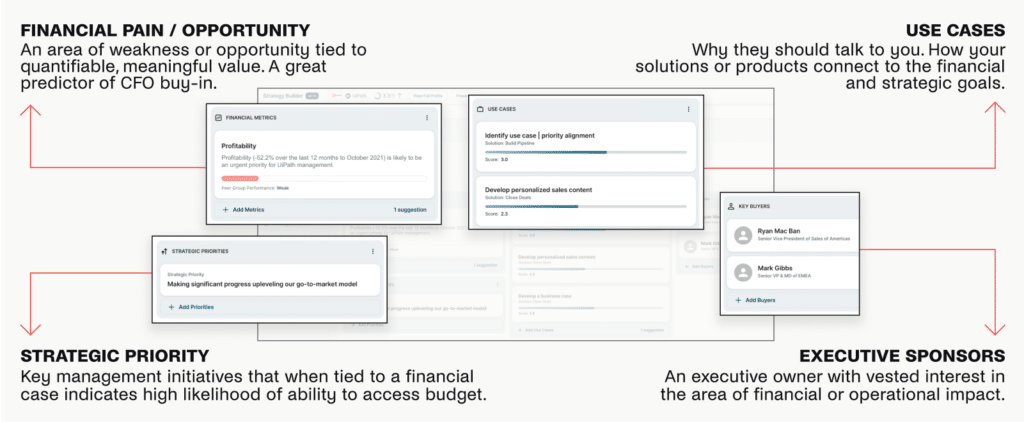
As today’s buyers become increasingly strategic, you as the seller must ramp up your game to match. Gone are the days of the naive introductory discovery call; you’re now expected to bring a well-researched, compelling point of view to each and every conversation.
To do that, you need a way to uncover a more valuable story for every account, one that connects the dots between buyers’ urgent needs and what you’re selling, so you can build bigger, better opportunities that benefit everyone. This is the heart of Strategic Relationship Management—and this is why Databook created Strategy Builder.
Now available as part of Databook’s advanced SRM platform, Strategy Builder is a game-changer for sellers looking to foster relationships that generate higher value deals. Here, we’ll take a closer look at what the application does and how you can use it to become a more strategic seller.
Databook’s SRM platform continuously scours 2 million+ corporate disclosures to identify strategic needs for tens of thousands of enterprises across all territories. Those data signals are then translated through an AI-powered business value graph and mapped directly to your unique Use Cases and sales motions.
Here’s the cool part: While you can access and leverage this data throughout the Databook platform, Strategy Builder lets you instantly assemble all of these real-time account insights into dynamic and interactive collections called Opportunity Roadmaps.

Each Opportunity Roadmap draws on specific, real-time buyer data to present a relevant narrative that connects to the account through four key areas:
Opportunity Roadmaps are visible to everyone you need to align to your sales strategy, keeping them consistently actionable across every organization. And when customer priorities and financial circumstances change, information in your Opportunity Roadmaps stays up-to-date automatically.
In other words, Opportunity Roadmaps are everything static account plans could never be.
Closing the gap between what B2B buyers need and what you’re able to deliver is what SRM is all about. Strategy Builder gives you the tools you need to make expert decisions and re-humanize your selling approach to build more strategic relationships.
While tactical sales tech is only geared toward helping you hit the numbers, Strategy Builder positions you to execute with exponential efficacy. No more tedious and time-wasting customer research. Easily show managers your ability to maximize the potential of each territory.
Strategy Builder ensures you have the ability to go beyond the planning phase and execute against Opportunity Roadmaps in the way you, the expert seller, determine most effective. Strategy Builder makes recommendations, but you can easily drill down to build your own powerful narratives. And you’ll build smarter pipeline by knowing a prospect’s potential up front.
Every seller with access to Strategy Builder can put together dynamic Opportunity Roadmaps. Additionally, Opportunity Roadmaps can be reviewed live with members of the team in a web presentation slide format that makes it easy for your team to generate strategic opportunities with you. Everyone, including GTM teams, remains fully aligned around the best message for any account—which means you can drive more effective outreach, collateral and meeting prep, shortening the sales cycle to close in less time.
In keeping with our mission to connect buyers and sellers through SRM, we’re excited to add Strategy Builder to our platform—primarily because it reignites the human element of sales that tactical tech has pushed aside. Like a compass, Strategy Builder provides evergreen, data-driven Opportunity Roadmaps that always point you in the right direction—but you’re steering the car. And that’s the way it should be. After all, this is your journey.
Watching Strategy Builder in action is the best way to understand how far it can take you. Connect with us for a quick, no-pressure demo today.
Our website uses cookies to provide you the best experience. However, by continuing to use our website, you agree to our use of cookies. For more information, read our Cookies Policy